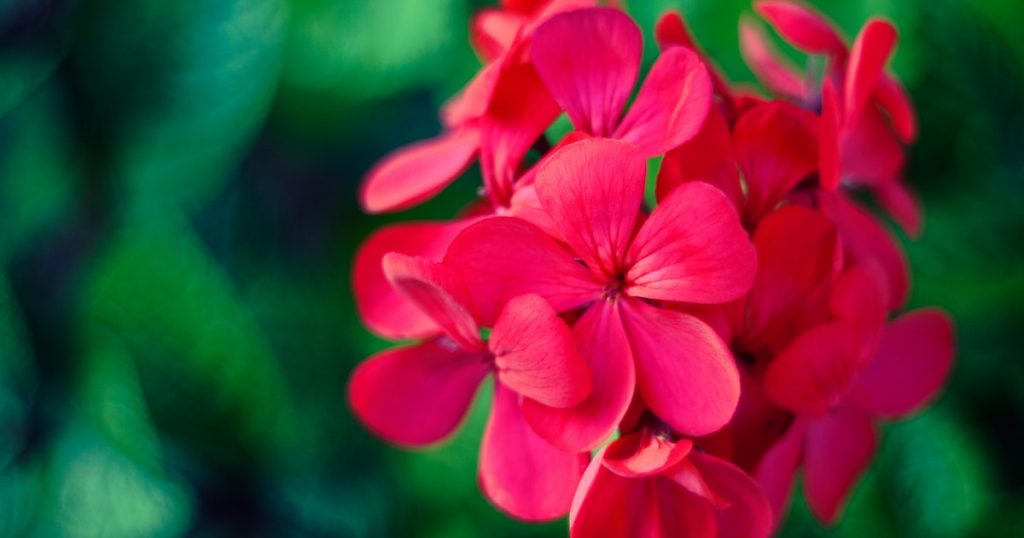Geraniums, also known as pelargoniums, are renowned for their vivid flowers and lengthy flowering period and are common plants in southern regions. They are typically cultivated as ornamentals in bed borders, miniature gardens, and hanging baskets since they require little upkeep. But what if this low-maintenance plant begins to look terrible?
The first thing to do is inspect the roots to ensure they are in a healthy condition, particularly if the entire plant looks terrible. If the roots are alright, you can refresh the compost or place the plant in a warm area with plenty of sunlight and some shade.
Keep reading below as we take you through the reasons why your geraniums may not be doing well.

Table of Contents
Why Are My Geraniums Not Doing Well?
We’ve listed some of the reasons why your geraniums may not be doing well. Keep reading below!
Too Little (or Too Much) Water
Geraniums can tolerate drought, although they thrive with moderate to frequent watering. Be careful to keep a check on them to prevent them from drying out. In order to ensure the longevity of your plants, you must put them in soil that drains effectively from the get-go.
These plants particularly dislike damp roots.
Planting In Bad Soil
The ideal choice for geranium care is, as previously said, fast-draining soil. They are more likely to succeed when put in rich soil that has been enriched with a bunch of organic compounds, whether in a container, bed, or border.
They shouldn’t require a lot of fertilizer if the soil is healthy. It is advised to fertilize the plants throughout their active development stages if they’re having trouble or if all you’ve got is sandy soil.
Allowing Them To Wither In The Sun
Geraniums can suffer greatly from the summer heat. Many plants, such as ordinary geraniums (Pelargonium x hortorum), will completely stop flowering when the temperature exceeds a certain point. Certain species and series, such as Americana, Orbit, and Cascade, are more resistant to high temperatures than others.
The plants will typically blossom once more when the weather changes and the temperatures decrease considerably. The bad news is that this heat check will temporarily obliterate the geranium pot’s blooms.
Planting In Deep Shade
Deep shade is not the answer to trying to help geraniums escape the burn, even though some might be delicate to the severe summer heat. Most still require enough sunshine to prosper. Partial shade and filtered sunlight are advised for geraniums since mild afternoon shadow is ideal for them.

Missing Deadheading
Geraniums may grow with minimal upkeep if they are planted in the proper locations and receive enough water. However, they are not completely hands-free plants. Don’t forget to eliminate the wasted blossoms to keep them blooming.
Young plants can be shaped, and their flowering time is extended by deadheading and pruning. Pinching the ends of immature plants is advised to help the plant take shape and promote the growth of side branches.
Forgetting about Pests
Aphids, whiteflies, and spider mites are a few of the garden pests that can harm geraniums. Keep a close watch on your plants to make sure no unwanted guests are settling down in the foliage. Flowers with torn petals and closed blooming buds are warning indications of an infestation.
What Should I Do If My Geraniums Look Terrible?
If there are only a few affected leaves and the rest of the plant appears healthy, a quick temperature shift may be to blame. Plants that have been relocated from a protected place to the outdoors may experience some “shock” and drop several leaves.
Remove the plant from its pot if the overall appearance is bad, and pay close attention to the roots:
If the roots are missing, it means something has gotten into the ground and devoured them. Most likely, this is a vine weevil. Even though they aren’t always visible to the naked eye, keep an eye out for the pests. Don’t worry; there are cures for this. If any healthy portions of the plant are left, take a clipping and root it.
The root system perishes if there are many brown roots. Overwatering or a composting issue is the most typical cause of this. As previously suggested, the only thing that can be done is to take a cut from whatever wholesome growth is still there.
Your plant should have a shot if the roots are nice and white, and there are many of them! Its appearance is a sign that it is unhappy with its current circumstances. Consider replenishing the compost, relocating the plant to a location that receives a lot of heat and light, and making sure the compost is wet.
Keep in mind that these plants are native to South Africa.
Even if you are successful in helping a plant recover, you should assess your overall growth environment and watering practices to lessen the probability of subsequent issues. Nevertheless, there is no such thing as a 100 percent chance of success; as gardeners, we can do our best.
This video shows how you can treat the root of a geranium:
How To Make Geraniums Flower More?
Geraniums thrive in warm, bright spaces with rich soil that is generally damp but not soggy for flowering. To avoid soaking in water puddles, pots should have holes in the bottom. Overwatering must be avoided since geraniums require oxygen at their roots.
The number of flowers you obtain from your plants will grow dramatically if you regularly feed them with a good geranium fertilizer. Nourish them once a week; the fertilizer’s high potash content promotes flower output. The outcomes are worth the minimal work required, and the process doesn’t take much time.
After all the hassle of planting it, it makes good sense to extract the finest show from a plant. This also applies to all your flowering plants. Use a fertilizer made specifically for containers for all your patio plants and potted fuchsias. For shrubs on the border, consider a fertilizer applied once a year.
Where Should I Plant Geraniums For The Best Outcomes?
Although they thrive in warm, sunny locations, geraniums may also thrive in regions with some shade. Avoid places with intense shade and standing water while distributing your geraniums through beds and borders. Geraniums are ideal for pots and a quick way to add color to your whole garden, particularly hanging pots and flower beds.
They don’t wither in the heat as other plants do, making them particularly suitable for locations that are prone to drought. Make sure that you keep them wet and give them some sun each day to achieve the best results.
Final Words
If you’re thinking, “my geraniums look terrible,” there are some things you can do to fix that. Geraniums don’t need as much maintenance as other flowers, but you still need to know what these plants need to develop healthily and vigorously.
We hope the advice in this article will help you grow strong and robust geraniums and flower throughout the year.
Recent Posts
Have you found yourself wondering, 'why is my bamboo growing so slow?' Despite the fact that bamboo plants are remarkably fast-growing, it can sometimes take months (or even years!) to see any signs...
Miracle-Gro is a huge help when you are trying to get decent yields out of your plants or if you want them to thrive. However, you may have noticed that a single dose of fertilizer does little to...
